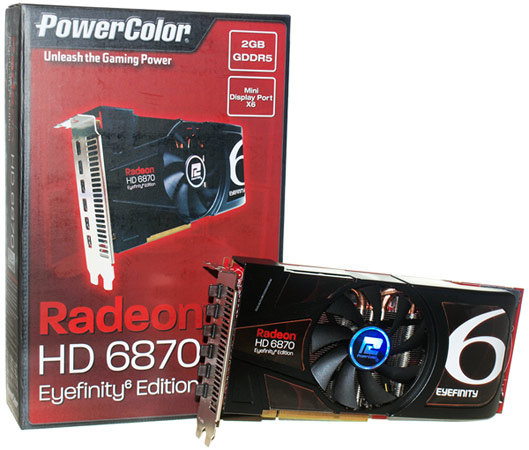AMD Radeon HD 6870 CrossFire with 5x1 Eyefinity
Introduction and the Eyefinity 6 Card
Way back in September of ’09, AMD launched the Radeon HD 5800 series, and along with it officially unveiled its Eyefinity multi-display technology, which now pervades all Radeon HD 5000 and 6000 series cards in one form or another. Leading up to the release of the 5800 series, AMD tried to keep Eyefinity a close guarded secret, so its arrival was a pleasant surprise for most consumers and a not so pleasant one for rival NVIDIA perhaps. Dual and multi-screen gaming wasn’t new per say, just ask die-hard Flight Simulator fans who have been doing it for years. However, AMD’s implementation was much more elegant than any of hacks or other solutions available in the past. And on higher-end cards, it allowed for easy integration of up to six monitors, which was unheard of at the time.
Since its initial introduction, AMD has continued to refine and optimize Eyefinity, while also working with game developers to ensure proper support in a multitude of titles. CrossFire support, which was available at launch, came a while back as well. DisplayPort-enabled monitors have gotten more affordable, cheap DP-to-DVI adapters have been made available, and the performance of more mainstream graphics cards has gotten good enough to push multiple displays with decent framerates, making the cost of entry somewhat palatable for even an extreme three or six monitor setup.

Available AMD Eyefinity Configurations
Part of the allure of AMD Eyefinity is its flexibility. There are many different screen configurations that can be supported, some of which are represented above. Depending on your needs, and desk real estate, monitors can be arranged in a multitude of different ways, with a mix of extended or mirrored desktops. In addition, and this is what set Eyefinity apart from legacy solutions, screens can also be combined in a what AMD calls a Display Group and they’ll act as a single large surface (AMD actually calls the underlying software that’s part of the Catalyst Control Center SLS).

Samsung's Sexy Six Screen Setup...
The single large surface can span up to six monitors, resulting in a huge expanse of screens with a massive number of pixels in play. A typical six screen setup, for example, comprised of relatively affordable 22” LCDs with native resolutions of 1920x1080, setup in a 3x2 arrangement, would have a combined resolution 5760x2160; that’s a boatload of pixels.
One of the more recent display group configurations to be supported by AMD is a 5x1 portrait arrangement. This king of setup is interesting because it’s more appealing to gamers than a six-screen 3x2 setup. With six screens in a 3x2 arrangement, the center of the SLS surface falls on the monitor bezels, which is not ideal for FPS games in particular. With a 5x1 setup, the center of the SLS surface is a full monitor, ideally centered on the gamer, and the remaining four screens extend outward, offering an unparalleled field of view.

PowerColor Radeon HD 6870 2GB Eyefinity 6 Edition
With the performance of more mainstream cards on the rise, monitor prices on a downward slide, and support for 5x1 Eyefinity available (sort of—more on that later), we decided to see what a pair of Radeon HD 6870 cards running in CrossFire mode could do with a quintet of screens out in front.
The cleanest way to pull off a 5x1 Eyefinity configuration, without using an array of adapters is with a card that has at least five, similar outputs, connected to matching monitors. To that end, we got our hands on a pair of PowerColor Radeon HD 6870 2GB Eyefinity 6 Edition cards, which have six mini-DP outputs. These cards sport 900MHz GPU clocks, with 2GB of GDDR5 memory running at 1050MHz (4.2Gbps effective), so they’ll perform right on part with reference Radeon HD 6870 cards, which have the same clocks, in most scenarios. The PowerColor card’s 2GB frame buffer, however, will give the card the breathing room necessary to support the ultra-high effective resolution of five screens linked together. We’re seeing 1GB graphics cards choke on some of today’s games when a single 30” monitor with a 2560x1600 resolution is used; at 5760x2160 1GB isn’t going to cut it with newer titles.






